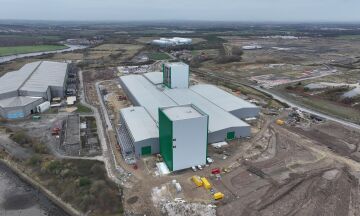
JDR achieved a major milestone by successfully completing the type test qualification of its next-generation 132kV static array cable, designed to support the growing demands of offshore wind farms. Additionally, the company expanded its global presence by opening a new service centre in Macaé, Brazil, to support the country’s energy sector. JDR is also set to open a £130 million subsea cable manufacturing facility in Cambois, Northumberland, further solidifying its role in supporting the UK’s offshore wind industry and net-zero ambitions.
2024
JDR entered a new phase of growth when it was acquired by TELE-FONIKA Kable (TFKable Group). This strategic partnership combined TFKable’s global reach with JDR’s expertise in subsea umbilicals and power cables, strengthening the company’s market position. In the same year, JDR launched its Vision 2020 initiative, focusing on innovation and expansion in both traditional and renewable energy markets.
2017
JDR successfully delivered its first steel tube umbilical for the Wintershall Ravn project, showcasing its ability to provide specialized subsea cable solutions for complex offshore developments.
2014
JDR established a 100,000-square-foot subsea power cable manufacturing facility in Hartlepool, making it the UK’s first dedicated plant of its kind. This expansion created 200 jobs and reinforced JDR’s position as a key supplier in the offshore energy market.
2009
JDR expanded internationally by opening a manufacturing facility in Sattahip, Thailand. While initial concerns about production quality arose, the facility quickly proved its efficiency and high standards. Entry into Renewables - Beatrice Demontrator.
2006
JDR relocated to a state-of-the-art facility at Littleport Innovation Park, marking a significant milestone in its development. The company also gained Investors in People accreditation. That same year, JDR supplied inter-array cables for the LAL Offshore Windfarm, which was the largest windfarm in the world at the time, reinforcing its growing role in renewable energy. NatWest Equity renamed Bridgepoint Capital
2000
BI Group acquired the Dutch company De Regt Special Cable and merged it with Jacques Cable Systems. The combined entity was renamed Jacques De Regt Cable Systems, later shortened to JDR Cable Systems Ltd., marking its growing presence in specialist cable solutions.
1994
A management consortium purchased the company, leading to its rebranding as Jacques Cable Systems Ltd. This change reflected its evolving expertise in special cable system design and manufacturing.
1988
Due to increasing demand in the diving industry, the company acquired the Littleport factory. G.H. Chaplin (Eng.) Ltd. relocated its umbilical assembly operations and hose and coupling manufacturing to this new site, while the Test Centre remained at Great Amwell.
1981
As demand for diving umbilicals grew, the company purchased the Koh-I-Nor Works in Royston to manufacture key components, including cables. The Great Amwell site continued as the main assembly facility for umbilicals.
1977
Managing Director Peter Jacques partnered with G.H. Chaplin & Co. to form Jacques Chaplin Engineering Ltd., based in Great Amwell, Hertfordshire. This partnership marked the company’s transition from a sales-focused business to an active manufacturer of industrial components.
1971
JDR has announced its plans to open a new Subsea cable manufacturing facility in Cambois, near Blyth, Northumberland. Array cable focus (to 132 kV), including new continuous catenary vulcanisation (CCV) line making this the only facility in the UK capable of full start-to-finish and quayside subsea cable manufacture.
2022
JDR installed the largest Horizontal Lay-Up Machine (HLM) in the UK at its Hartlepool facility. This investment doubled production capacity and enabled the manufacture of complex subsea umbilicals, essential for offshore oil, gas, and renewable energy sectors. The HLM reinforced JDR’s leadership in subsea technology and was a key part of the company’s ongoing expansion to serve its global clients.
2016
JDR introduced a Vertical Layup Machine (VLM) at Hartlepool to enhance production capacity. That same year, the company launched the JDR Charity Committee, which hosted its first Charity Summer Ball. This event became an annual tradition, raising significant funds for local causes and strengthening JDR’s community engagement. Marine Cables Division (De Regt) sold
2011
JDR was acquired by Vision Capital, Goldman Sachs, and management, purchasing the company from Bridgepoint Capital. This acquisition enabled a £30 million investment program, leading to the development of a state-of-the-art manufacturing facility in Hartlepool.
2007
JDR pioneered the offshore wind industry by delivering its first 33kV inter-array cables for the Beatrice Offshore Windfarm Demonstrator Project. This groundbreaking initiative demonstrated deepwater windfarm technology and helped shape future subsea cable solutions.
2001
The BI Group sold JDR Cable Systems Ltd. to NatWest Equity Partners, the venture capital division of National Westminster Bank. This acquisition brought new financial backing and strategic direction for future growth.
1998
Jacques Cable Systems Ltd. was acquired by Bromsgrove Industries plc (BI Group) and integrated into BI’s Marine & Offshore Division, further strengthening its position in the subsea and offshore market.
1991
The company was acquired by the Rotork Group, a move that enhanced its market position. In recognition of the strong industry reputation of its umbilicals and hoses, the company was renamed Jacques Rotork Ltd. in 1984.
1983
G.H. Chaplin (Eng.) Ltd. was established at Great Amwell to focus on the manufacture of hose-end couplings, umbilical assembly, and testing. The newly created Test Centre ensured compliance with industry classification standards set by Lloyd’s Register of Shipping and Det Norske Veritas.
1978
The company identified a need for durable, flexible, and non-kink hoses for diving applications, leading to the design, development, and manufacture of Umbilical Life Support Systems. This shift positioned the company within the marine and offshore industry.
1974
The company was established under the name Pneu Hydraulics Ltd., initially operating as a design and sales firm focused on industrial applications.
1966JDR achieved a major milestone by successfully completing the type test qualification of its next-generation 132kV static array cable, designed to support the growing demands of offshore wind farms. Additionally, the company expanded its global presence by opening a new service centre in Macaé, Brazil, to support the country’s energy sector. JDR is also set to open a £130 million subsea cable manufacturing facility in Cambois, Northumberland, further solidifying its role in supporting the UK’s offshore wind industry and net-zero ambitions.

JDR has announced its plans to open a new Subsea cable manufacturing facility in Cambois, near Blyth, Northumberland. Array cable focus (to 132 kV), including new continuous catenary vulcanisation (CCV) line making this the only facility in the UK capable of full start-to-finish and quayside subsea cable manufacture.

JDR entered a new phase of growth when it was acquired by TELE-FONIKA Kable (TFKable Group). This strategic partnership combined TFKable’s global reach with JDR’s expertise in subsea umbilicals and power cables, strengthening the company’s market position. In the same year, JDR launched its Vision 2020 initiative, focusing on innovation and expansion in both traditional and renewable energy markets.

JDR installed the largest Horizontal Lay-Up Machine (HLM) in the UK at its Hartlepool facility. This investment doubled production capacity and enabled the manufacture of complex subsea umbilicals, essential for offshore oil, gas, and renewable energy sectors. The HLM reinforced JDR’s leadership in subsea technology and was a key part of the company’s ongoing expansion to serve its global clients.

JDR successfully delivered its first steel tube umbilical for the Wintershall Ravn project, showcasing its ability to provide specialized subsea cable solutions for complex offshore developments.

JDR introduced a Vertical Layup Machine (VLM) at Hartlepool to enhance production capacity. That same year, the company launched the JDR Charity Committee, which hosted its first Charity Summer Ball. This event became an annual tradition, raising significant funds for local causes and strengthening JDR’s community engagement. Marine Cables Division (De Regt) sold

JDR established a 100,000-square-foot subsea power cable manufacturing facility in Hartlepool, making it the UK’s first dedicated plant of its kind. This expansion created 200 jobs and reinforced JDR’s position as a key supplier in the offshore energy market.

JDR was acquired by Vision Capital, Goldman Sachs, and management, purchasing the company from Bridgepoint Capital. This acquisition enabled a £30 million investment program, leading to the development of a state-of-the-art manufacturing facility in Hartlepool.

JDR expanded internationally by opening a manufacturing facility in Sattahip, Thailand. While initial concerns about production quality arose, the facility quickly proved its efficiency and high standards. Entry into Renewables - Beatrice Demontrator.

JDR pioneered the offshore wind industry by delivering its first 33kV inter-array cables for the Beatrice Offshore Windfarm Demonstrator Project. This groundbreaking initiative demonstrated deepwater windfarm technology and helped shape future subsea cable solutions.

JDR relocated to a state-of-the-art facility at Littleport Innovation Park, marking a significant milestone in its development. The company also gained Investors in People accreditation. That same year, JDR supplied inter-array cables for the LAL Offshore Windfarm, which was the largest windfarm in the world at the time, reinforcing its growing role in renewable energy. NatWest Equity renamed Bridgepoint Capital

The BI Group sold JDR Cable Systems Ltd. to NatWest Equity Partners, the venture capital division of National Westminster Bank. This acquisition brought new financial backing and strategic direction for future growth.

BI Group acquired the Dutch company De Regt Special Cable and merged it with Jacques Cable Systems. The combined entity was renamed Jacques De Regt Cable Systems, later shortened to JDR Cable Systems Ltd., marking its growing presence in specialist cable solutions.

Jacques Cable Systems Ltd. was acquired by Bromsgrove Industries plc (BI Group) and integrated into BI’s Marine & Offshore Division, further strengthening its position in the subsea and offshore market.

A management consortium purchased the company, leading to its rebranding as Jacques Cable Systems Ltd. This change reflected its evolving expertise in special cable system design and manufacturing.

The company was acquired by the Rotork Group, a move that enhanced its market position. In recognition of the strong industry reputation of its umbilicals and hoses, the company was renamed Jacques Rotork Ltd. in 1984.

Due to increasing demand in the diving industry, the company acquired the Littleport factory. G.H. Chaplin (Eng.) Ltd. relocated its umbilical assembly operations and hose and coupling manufacturing to this new site, while the Test Centre remained at Great Amwell.

G.H. Chaplin (Eng.) Ltd. was established at Great Amwell to focus on the manufacture of hose-end couplings, umbilical assembly, and testing. The newly created Test Centre ensured compliance with industry classification standards set by Lloyd’s Register of Shipping and Det Norske Veritas.

As demand for diving umbilicals grew, the company purchased the Koh-I-Nor Works in Royston to manufacture key components, including cables. The Great Amwell site continued as the main assembly facility for umbilicals.

The company identified a need for durable, flexible, and non-kink hoses for diving applications, leading to the design, development, and manufacture of Umbilical Life Support Systems. This shift positioned the company within the marine and offshore industry.

Managing Director Peter Jacques partnered with G.H. Chaplin & Co. to form Jacques Chaplin Engineering Ltd., based in Great Amwell, Hertfordshire. This partnership marked the company’s transition from a sales-focused business to an active manufacturer of industrial components.

The company was established under the name Pneu Hydraulics Ltd., initially operating as a design and sales firm focused on industrial applications.


